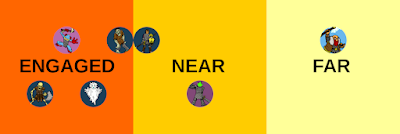I've been thinking about something to make rpg combat easier to handle, both for the GM that doesn't want to have to prepare a full battlemat for every fight, and the player that has difficulty with pure, abstract "theatre of the mind" play. This is my attempt to resolve that tension. I remember The One Ring had something like this, so I may be just reinventing the wheel, but oh well it kept me occupied for an afternoon.
The basic idea is that a combat is split into three bands: Engaged, Near, and Far.
(You can click to see the image at a slightly larger size.)
Anyone in the Engaged band is, um, engaged. Anyone can hit anyone else, and it's a proper mêlée. That frog person is in trouble. Although it's a brawl, you may decide that "small" ranged weapons such as pistols and thrown weapons are effective in this section.
Anyone in the Near band can hit characters in Engaged and Near with ranged attacks. Engaged characters can attack those in Near with ranged attacks, but may face penalties or free attacks or similar from others in Engaged. Characters in Near can hit each other with ranged attacks, but for anything more up close and personal see NEE. Most ranged weapons, like bows or SMGs, fit in here.
Characters in Far are probably out of the fight but may have extra long range weapons that can affect the battle and hit anyone in any band. This is where your long distance spells, high-tech sniper rifles, or siege weapons come in.
You'll note that the guard (Near) and the zombie (Engaged) are adjacent on the "map", but remember this is abstract positioning and they are in different bands. In "reality" they could be 100 metres apart.
Moving
Characters can move between bands by using their basic combat move, as defined in your game of choice. Leaving Engaged will require some sort of dodge or fighting withdrawal action to escape the mêlée without harm. It takes one action/turn/whatever to move between sections; if your game allows double moves or sprinting, then you can move two bands.
Get the Archers!
My thinking is that if you want to go and stab the archers, you use your move action as normal, and that instead "pulls" the archer from Near to Engaged. It's a bit fuzzy because they haven't moved, rather the fight has sprawled and they've been sucked into its periphery. Don't think too hard about it; this is supposed to make combat simpler!
Backstabber!
Backstabs work as normal, I think. The stabber makes a stealth test -- which probably makes them ineligible for being attacked, even if Engaged -- then tries their sneak attack. It should all be compatible with this approach.
Flanking
Flanking and similar sort of tactical positioning is abstract and simple: if your side outnumbers the opponents in the Engaged band, you can gain a flanking bonus if your game has one.
Fleeing
You can handle running away as normal for your game. Or... If someone wants to flee combat, then they need to move from Engaged to Near to Far, and then once more to get "out" of the Far band, for a total of three movement actions.
Initiative
None of this should make any difference to your game's imitative rules, but I would consider applying some sort of penalty to those in the Far band. Perhaps they go last, or get a -10, or something like that, to represent their distance from the action.
NEE
If one Near character decides to engage another, then I suggest putting them in a temporary Near-Engaged Enclave (NEE). They are still at a distance from the main mêlée but are Engaged with each other. They can still attack those in the Engaged band, but would face the same penalties as someone attacking from Engaged to Near would. As soon as their personal duel ends, the survivors return to their Near status.
Surprise!
I don't think anything here should affect surprise, unless your game has some weird surprise mechanics.
That's it! I haven't tested it yet, but I'll try to use it as soon as I can. It will be interesting to see what effects if any it will have on gameplay. I imagine one thing it could encourage is a greater emphasis on marching order, with the elf ranger -- for example -- hanging back so she can take up a Near position if combat starts.
If you have a chance to try it out, let me know how you get on!

3:16 Carnage Among The Stars (Cubicle 7) had a very similar range system. I only played it once at a convention (Dragonmeet) many years ago and it was great. I am also a big fan of the fate style Zone Maps which are a neat way to describe things in relation to one another. I first encountered these in Starblazer Adventures (Cubicle 7) and they use them to describe anything from a building all the way up to a galaxy in a rough and ready way which doesn't require you to be an ace cartographer and is easily understandable by the players.
ReplyDeleteI have a copy of 3:16 somewhere, although I've never played it, so maybe I picked it up from there. I may also go and look at Starblazer Adventures for inspiration.
DeleteThanks for reading!